3D Mineral Prospectivity Modeling for the Low-Sulfidation Epithermal Gold Deposit: A Case Study of the Axi Gold Deposit, Western Tianshan, NW China
Abstract
1. Introduction
2. Geological Background
2.1. Regional and Deposit Geology
2.2. Metallogenic Model
3. Methodology
3.1. Datasets
3.2. 3D Geological Modeling
3.3. Spatial Analysis of Geological Features
3.4. Prospectivity Modeling and Assessing
3.4.1. Support Vector Regression Model
3.4.2. Comparison and Assessment
4. Results
4.1. Gold Distribution
4.2. Spatial Analysis of Geological Features
4.3. The Efficiency of Prospectivity Models
4.4. Target Appraisal
5. Discussion
5.1. Insights from 3D Models and Spatial Analysis
5.2. Application of Support Vector Regression Model
- (1)
- As previously mentioned, the known Au-grade in Axi gold deposit changes sharply and unevenly distributes in space, resulting in the poor performance of traditional prospectivity methods (e.g., MNR and fuzzy WofE). Nevertheless, GA-SVR is able to overcome the aforesaid disadvantages, because of it is irrespective of data distribution and outliers, making better generalization performance [30,32,65,66].
- (2)
- The spatial analysis results indicate that there is a complicated non-linear spatial association between gold occurrence and geological features, due to the superimposition of various geological events in the ore-forming processes that are difficult to quantify [57]. SVR, characterized by non-linearity, self-learning, and robustness, constructs a higher dimensional feature space from the lower dimensional input space via non-linear mapping [20,50,51]. Then, the complicated non-linear spatial association in the original low dimensional input space is treated as an oversimplified linear regression solution in high dimensional feature space, and therefore it can be commendably quantified and the prediction ability is improved [54,62].
- (3)
- There are many parameters that have to be determined using expert opinion in traditional prospectivity models (e.g., weight definition in fuzzy WofE), resulting in systemic bias and error [20,79]. By contrast, GA-SVR obtains optimal parameters that could produce the best prediction via GA with less subjectivity [30,32,61].
5.3. Exploration Significanture for LS Epithermal Deposit
6. Conclusions
Author Contributions
Funding
Acknowledgments
Conflicts of Interest
References
- Hedenquist, J.W.; Arribas, A.; Gonzales-Urien, E. Exploration for epithermal gold deposits. Rev. Econ. Geol. 2000, 13, 245–277. [Google Scholar]
- Sillitoe, R.H.; Hedenquist, J.W. Linkages between volcanotectonic settings, ore-fluid compositions, and epithermal precious metal deposits. In Volcanic, Geothermal, and Ore-Forming Fluids: Rulers and Witnesses of Processes within the Earth; Simmons, S.F., Graham, I., Eds.; Society of Economic Geologists, Inc.: Littleton, CO, USA, 2003; pp. 315–345. [Google Scholar]
- Simmons, S.F.; White, N.C.; John, D.A. Geological characteristics of epithermal precious and base metal deposits. In Economic Geology One Hundredth Anniversary Volume 1905–2005 Society of Economic Geologists; Hedenquist, J.W., Thompson, J.F.H., Goldfarb, R.J., Richards, J.P., Eds.; Society of Economic Geologists, Inc.: Littleton, CO, USA, 2005; pp. 485–522. [Google Scholar]
- Sillitoe, R.H. Epithermal paleosurfaces. Miner. Depos. 2015, 50, 767–793. [Google Scholar] [CrossRef]
- Cooke, D.R.; Simmons, S.F. Characteristics and genesis of epithermal gold deposits. Rev. Econ. Geol. 2000, 13, 221–244. [Google Scholar]
- John, D.A.; Hofstra, A.H.; Fleck, R.J.; Brummer, J.E.; Saderholm, E.C. Geologic setting and genesis of the Mule Canyon low-sulfidation epithermal gold-silver deposit, north-central Nevada. Econ. Geol. 2003, 98, 425–463. [Google Scholar] [CrossRef]
- Clark, L.V.; Gemmell, J.B. Vein stratigraphy, mineralogy, and metal zonation of the kencana low-sulfidation epithermal Au–Ag deposit, Gosowong goldfield, Halmahera island, Indonesia. Econ. Geol. 2018, 113, 209–236. [Google Scholar] [CrossRef]
- Simmons, S.F.; Browne, P.R. Hydrothermal minerals and precious metals in the Broadlands-Ohaaki geothermal system: Implications for understanding low-sulfidation epithermal environments. Econ. Geol. 2000, 95, 971–999. [Google Scholar] [CrossRef]
- Henley, R.W. The geothermal framework of epithermal deposits. Rev. Econ. Geol. 1985, 2, 1–24. [Google Scholar]
- Rowland, J.V.; Simmons, S.F. Hydrologic, magmatic, and tectonic controls on hydrothermal flow, Taupo Volcanic Zone, New Zealand: Implications for the formation of epithermal vein deposits. Econ. Geol. 2012, 107, 427–457. [Google Scholar] [CrossRef]
- John, D.A.; Vikre, P.G.; du Bray, E.A.; Blakely, R.J.; Fey, D.L.; Rockwell, B.W.; Mauk, J.L.; Anderson, E.D.; Graybeal, F.T. Descriptive Models for Epithermal Gold-Silver Deposits: Chapter Q in MINERAL Deposit Models for Resource Assessment (No. 2010-5070-Q); US Geological Survey: Reston, VA, USA, 2018.
- Cox, S.F.; Knackstedt, M.A.; Brown, J. Principle of structural control on permeability and fluid flow in hydrothermal systems. In Structural Control on Ore Genesis; Richards, J.P., Tosdal, R.M., Eds.; Society of Economic Geologists, Inc.: Littleton, CO, USA, 2001; Volume 14, pp. 1–24. [Google Scholar]
- Berger, B.R.; Tingley, J.V.; Drew, L.J. Structural localization and origin of compartmentalized fluid flow, Comstock Lode, Virginia City, Nevada. Econ. Geol. 2003, 98, 387–408. [Google Scholar] [CrossRef]
- Carranza, E.J.M. Controls on mineral deposit occurrence inferred from analysis of their spatial pattern and spatial association with geological features. Ore Geol. Rev. 2009, 35, 383–400. [Google Scholar] [CrossRef]
- Xiao, F.; Chen, J.; Hou, W.; Wang, Z.; Zhou, Y.; Erten, O. A spatially weighted singularity mapping method applied to identify epithermal Ag and Pb-Zn polymetallic mineralization associated geochemical anomaly in Northwest Zhejiang, China. J. Geochem. Explor. 2018, 189, 122–137. [Google Scholar] [CrossRef]
- De Palomera, P.A.; van Ruitenbeek, F.J.; Carranza, E.J.M. Prospectivity for epithermal gold–silver deposits in the Deseado Massif, Argentina. Ore Geol. Rev. 2015, 71, 484–501. [Google Scholar] [CrossRef]
- Li, N.; Bagas, L.; Li, X.H.; Xiao, K.Y.; Li, Y.; Ying, L.J.; Song, X.L. An improved buffer analysis technique for model-based 3D mineral potential mapping and its application. Ore Geol. Rev. 2016, 76, 94–107. [Google Scholar] [CrossRef]
- Mao, X.; Zhang, B.; Deng, H.; Zou, Y.; Chen, J. Three-dimensional morphological analysis method for geologic bodies and its parallel implementation. Comput. Geosci. 2016, 96, 11–22. [Google Scholar] [CrossRef]
- Zhang, M.; Zhou, G.; Shen, L.; Zhao, W.; Liao, B.; Yuan, F.; Li, X.; Hu, X.; Wang, C. Comparison of 3D prospectivity modeling methods for Fe–Cu skarn deposits: A case study of the Zhuchong Fe–Cu deposit in the Yueshan orefield (Anhui), eastern China. Ore Geol. Rev. 2019, 114, 103126. [Google Scholar] [CrossRef]
- Mao, X.; Ren, J.; Liu, Z.; Chen, J.; Tang, L.; Deng, H.; Bayless, R.C.; Yang, B.; Wang, M.; Liu, C. Three-dimensional prospectivity modeling of the Jiaojia-type gold deposit, Jiaodong Peninsula, Eastern China: A case study of the Dayingezhuang deposit. J. Geochem. Explor. 2019, 203, 27–44. [Google Scholar] [CrossRef]
- Qin, Y.Z.; Liu, L.M. Quantitative 3D Association of Geological Factors and Geophysical Fields with Mineralization and Its Significance for Ore Prediction: An Example from Anqing Orefield, China. Minerals 2018, 8, 300. [Google Scholar] [CrossRef]
- Yuan, F.; Li, X.H.; Zhang, M.M.; Jowitt, S.M.; Jia, C.; Zheng, T.K.; Zhou, T.F. Three-dimensional weights of evidence-based prospectivity modeling: A case study of the Baixiangshan mining area, Ningwu Basin, Middle and Lower Yangtze Metallogenic Belt, China. J. Geochem. Explor. 2014, 145, 82–97. [Google Scholar] [CrossRef]
- Carranza, E.J.M.; Laborte, A.G. Data-driven predictive mapping of gold prospectivity, Baguio district, Philippines: Application of Random Forests algorithm. Ore Geol. Rev. 2015, 71, 777–787. [Google Scholar] [CrossRef]
- Rodriguez-Galiano, V.; Sanchez-Castillo, M.; Chica-Olmo, M.; Chica-Rivas, M. Machine learning predictive models for mineral prospectivity: An evaluation of neural networks, random forest, regression trees and support vector machines. Ore Geol. Rev. 2015, 71, 804–818. [Google Scholar] [CrossRef]
- Sun, T.; Chen, F.; Zhong, L.; Liu, W.; Wang, Y. GIS-based mineral prospectivity mapping using machine learning methods: A case study from Tongling ore district, eastern China. Ore Geol. Rev. 2019, 109, 26–49. [Google Scholar] [CrossRef]
- Porwal, A.; Carranza, E.J.M.; Hale, M. Artificial Neural Networks for Mineral-Potential Mapping: A Case Study from Aravalli Province, Western India. Nat. Resour. Res. 2003, 12, 155–171. [Google Scholar] [CrossRef]
- Harris, J.R.; Grunsky, E.; Behnia, P.; Corrigan, D. Data- and knowledge-driven mineral prospectivity maps for Canada’s North. Ore Geol. Rev. 2015, 71, 788–803. [Google Scholar] [CrossRef]
- Juliani, C.; Ellefmo, S.L. Prospectivity Mapping of Mineral Deposits in Northern Norway Using Radial Basis Function Neural Networks. Minerals 2019, 9, 131. [Google Scholar] [CrossRef]
- Hong, W.C.; Dong, Y.; Zhang, W.Y.; Chen, L.Y.; Panigrahi, B.K. Cyclic electric load forecasting by seasonal SVR with chaotic genetic algorithm. Int. J. Electr. Power 2013, 44, 604–614. [Google Scholar] [CrossRef]
- Oyehan, T.A.; Alade, I.O.; Bagudu, A.; Sulaiman, K.O.; Olatunji, S.O.; Saleh, T.A. Predicting of the refractive index of haemoglobin using the Hybrid GA-SVR approach. Comput. Biol. Med. 2018, 98, 85–92. [Google Scholar] [CrossRef]
- Tang, X.; Wang, L.; Cheng, J.; Chen, J.; Sheng, V. Forecasting Model Based on Information-Granulated GA-SVR and ARIMA for Producer Price Index. Tech Sci. Press 2019, 58, 463–491. [Google Scholar] [CrossRef]
- Roushangar, K.; Koosheh, A. Evaluation of GA-SVR method for modeling bed load transport in gravel-bed rivers. J. Hydrol. 2015, 527, 1142–1152. [Google Scholar] [CrossRef]
- An, F.; Zhu, Y. Geology and geochemistry of the Early Permian Axi low-sulfidation epithermal gold deposit in North Tianshan (NW China). Ore Geol. Rev. 2018, 100, 12–30. [Google Scholar] [CrossRef]
- Zhang, B.; Li, N.; Shu, S.P.; Wang, W.; Yu, J.; Chen, X.; Ye, T.; Chen, Y.J. Textural and compositional evolution of Au-hosting Fe–S–As minerals at the Axi epithermal gold deposit, Western Tianshan, NW China. Ore Geol. Rev. 2018, 100, 31–50. [Google Scholar] [CrossRef]
- Liu, Z.; Mao, X.; Deng, H.; Li, B.; Zhang, S.; Lai, J.; Bayless, R.C.; Pan, M.; Li, L.; Shang, Q. Hydrothermal processes at the Axi epithermal Au deposit, western Tianshan: Insights from geochemical effects of alteration, mineralization and trace elements in pyrite. Ore Geol. Rev. 2018, 102, 368–385. [Google Scholar] [CrossRef]
- Zhai, W.; Sun, X.; Sun, W.; Su, L.; He, X.; Wu, Y. Geology, geochemistry, and genesis of Axi: A Paleozoic low-sulfidation type epithermal gold deposit in Xinjiang, China. Ore Geol. Rev. 2009, 36, 265–281. [Google Scholar] [CrossRef]
- Liu, Z.; Mao, X.; Ackerman, L.; Li, B.; Dick, J.M.; Yu, M.; Peng, J.; Shahzad, S.M. Two-stage gold mineralization of the Axi epithermal Au deposit, Western Tianshan, NW China: Evidence from Re–Os dating, S isotope, and trace elements of pyrite. Miner. Depos. 2019. [Google Scholar] [CrossRef]
- Zhao, X.; Xue, C.; Chi, G.; Wang, H.; Qi, T. Epithermal Au and polymetallic mineralization in the Tulasu Basin, western Tianshan, NW China: Potential for the discovery of porphyry CuAu deposits. Ore Geol. Rev. 2014, 60, 76–96. [Google Scholar] [CrossRef]
- An, F.; Zhu, Y.; Wei, S.; Lai, S. An Early Devonian to Early Carboniferous volcanic arc in North Tianshan, NW China: Geochronological and geochemical evidence from volcanic rocks. J. Asian Earth Sci. 2013, 78, 100–113. [Google Scholar] [CrossRef]
- Tang, G.J.; Wang, Q.; Wyman, D.A.; Sun, M.; Zhao, Z.H.; Jiang, Z.Q. Petrogenesis of gold-mineralized magmatic rocks of the Taerbieke area, northwestern Tianshan (western China), Constraints from geochronology, geochemistry and Sr–Nd–Pb–Hf isotopic compositions. J. Asian Earth Sci. 2013, 74, 113–128. [Google Scholar] [CrossRef]
- Wei, J.L.; Cao, X.Z.; Xu, B.J.; Zhang, W.S.; Rao, D.P.; Huang, L.W. Erosion and post-mineralization change of Axi epithermal gold deposit in Western Tianshan Mountains. Miner. Depos. 2014, 33, 241–254. (In Chinese) [Google Scholar]
- Jessell, M.; Ailleres, L.; De Kemp, E.; Lindsay, M.; Wellmann, F.; Hillier, M.; Laurent, G.; Carmichael, T.; Martin, R. Next Generation Three-Dimensional Geologic Modeling and Inversion. In Building Exploration Capability for the 21st Century; Kelley, K.D., Golden, H.C., Eds.; Soc Economic Geologists, Inc.: Littleton, CO, USA, 2014; pp. 261–272. [Google Scholar]
- Li, X.; Yuan, F.; Zhang, M.; Jowitt, S.M.; Ord, A.; Zhou, T.; Dai, W. 3D computational simulation-based mineral prospectivity modeling for exploration for concealed Fe–Cu skarn-type mineralization within the Yueshan orefield, Anqing district, Anhui Province, China. Ore Geol. Rev. 2019, 105, 1–17. [Google Scholar] [CrossRef]
- Li, N.; Song, X.; Xiao, K.; Li, S.; Li, C.; Wang, K. Part II: A demonstration of integrating multiple-scale 3D modelling into GIS-based prospectivity analysis: A case study of the Huayuan-Malichang district, China. Ore Geol. Rev. 2018, 95, 292–305. [Google Scholar] [CrossRef]
- Sporli, K.B.; Cargill, H. Structural Evolution of a World-Class Epithermal Orebody: The Martha Hill Deposit, Waihi, New Zealand. Econ. Geol. 2011, 106, 975–998. [Google Scholar] [CrossRef][Green Version]
- Jowitt, S.M.; Cooper, K.; Squire, R.J.; Thebaud, N.; Fisher, L.A.; Cas, R.A.F.; Pegg, I. Geology, mineralogy, and geochemistry of magnetite-associated Au mineralization of the ultramafic-basalt greenstone hosted Crusader Complex, Agnew Gold Camp, Eastern Yilgarn Craton, Western Australia; a Late Archean intrusion-related Au deposit? Ore Geol. Rev. 2014, 56, 53–72. [Google Scholar] [CrossRef]
- Mao, X.; Tang, Y.; Lai, J.; Zou, Y.; Chen, J.; Peng, S.; Shao, Y.J. Three Dimensional Structure of Metallogenic Geologic Bodies in the Fenghuangshan Ore Field and Ore-controlling Geological Factors. Acta Geol. Sin. 2011, 85, 1507–1518. (In Chinese) [Google Scholar]
- Mao, X.; Zhao, Y.; Tang, Y.; Peng, Z.; Chen, J.; Deng, H. Three-dimensional morphological analysis method for geological interfaces based on TIN and its application. J. Cent. South Univ. 2013, 44, 1493–1499. (In Chinese) [Google Scholar]
- Zuo, R. A nonlinear controlling function of geological features on magmatic-hydrothermal mineralization. Sci. Rep. 2016, 6, 27127. [Google Scholar] [CrossRef] [PubMed]
- Abedi, M.; Norouzi, G.-H.; Bahroudi, A. Support vector machine for multi-classification of mineral prospectivity areas. Comput. Geosci. 2012, 46, 272–283. [Google Scholar] [CrossRef]
- Zuo, R.; Carranza, E.J.M. Support vector machine: A tool for mapping mineral prospectivity. Comput. Geosci. 2011, 37, 1967–1975. [Google Scholar] [CrossRef]
- Shabankareh, M.; Hezarkhani, A. Application of support vector machines for copper potential mapping in Kerman region, Iran. J. Afr. Earth Sci. 2017, 128, 116–126. [Google Scholar] [CrossRef]
- Carranza, E.J.M. Geocomputation of mineral exploration targets. Comput. Geosci. 2011, 37, 1907–1916. [Google Scholar] [CrossRef]
- Li, X.; Luo, A.; Li, J.; Li, Y. Air Pollutant Concentration Forecast Based on Support Vector Regression and Quantum-Behaved Particle Swarm Optimization. Environ. Model. Assess. 2018, 24, 205–222. [Google Scholar] [CrossRef]
- Santamaria-Bonfil, G.; Reyes-Ballesteros, A.; Gershenson, C. Wind speed forecasting for wind farms: A method based on support vector regression. Renew. Energy 2016, 85, 790–809. [Google Scholar] [CrossRef]
- Patel, A.K.; Chatterjee, S.; Gorai, A.K. Development of a machine vision system using the support vector machine regression (SVR) algorithm for the online prediction of iron ore grades. Earth Sci. Inf. 2019, 12, 197–210. [Google Scholar] [CrossRef]
- Cheng, Q. Non-Linear Theory and Power-Law Models for Information Integration and Mineral Resources Quantitative Assessments. Math. Geosci. 2008, 40, 503–532. [Google Scholar] [CrossRef]
- Yousefi, M.; Carranza, E.J.M. Prediction–area (P–A) plot and C–A fractal analysis to classify and evaluate evidential maps for mineral prospectivity modeling. Comput. Geosci. 2015, 79, 69–81. [Google Scholar] [CrossRef]
- Nykänen, V.; Lahti, I.; Niiranen, T.; Korhonen, K. Receiver operating characteristics (ROC) as validation tool for prospectivity models—A magmatic Ni–Cu case study from the Central Lapland Greenstone Belt, Northern Finland. Ore Geol. Rev. 2015, 71, 853–860. [Google Scholar] [CrossRef]
- Vapnik, V.N. The Nature of Statistical Learning Theory; Springer: New York, NY, USA, 1995. [Google Scholar] [CrossRef]
- Wang, L.; Wang, C.; Khoshnevisan, S.; Ge, Y.; Sun, Z. Determination of two-dimensional joint roughness coefficient using support vector regression and factor analysis. Eng. Geol. 2017, 231, 238–251. [Google Scholar] [CrossRef]
- Wang, J.; Li, Y. Short-Term Wind Speed Prediction Using Signal Preprocessing Technique and Evolutionary Support Vector Regression. Neural Process. Lett. 2017, 48, 1043–1061. [Google Scholar] [CrossRef]
- Scholkopf, B.; Sung, K.K.; Burges, C.J.C.; Girosi, F.; Niyogi, P.; Poggio, T. Comparing support vector machines with Gaussian kernels to radial basis function classifiers. IEEE Trans. Signal Proces. 1997, 45, 2758–2765. [Google Scholar] [CrossRef]
- Ghaedi, M.; Dashtian, K.; Ghaedi, A.M.; Dehghanian, N. A hybrid model of support vector regression with genetic algorithm for forecasting adsorption of malachite green onto multi-walled carbon nanotubes: Central composite design optimization. Phys. Chem. Chem. Phys. 2016, 18, 13310–13321. [Google Scholar] [CrossRef]
- Xin, N.; Gu, X.F.; Wu, H.; Hu, Y.Z.; Yang, Z.L. Application of genetic algorithm-support vector regression (GA-SVR) for quantitative analysis of herbal medicines. J. Chemom. 2012, 26, 353–360. [Google Scholar] [CrossRef]
- Liu, S.; Tai, H.; Ding, Q.; Li, D.; Xu, L.; Wei, Y. A hybrid approach of support vector regression with genetic algorithm optimization for aquaculture water quality prediction. Math. Comput. Model. 2013, 58, 458–465. [Google Scholar] [CrossRef]
- Stanley, K.O.; Clune, J.; Lehman, J.; Miikkulainen, R. Designing neural networks through neuroevolution. Nat. Mach. Intell. 2019, 1, 24–35. [Google Scholar] [CrossRef]
- Chang, C.C.; Lin, C.J. LIBSVM: A Library for Support Vector Machines. ACM Trans. Intell. Syst. Technol. 2011, 2. [Google Scholar] [CrossRef]
- Cheng, Q.M.; Agterberg, F.P. Fuzzy Weights of Evidence Method and Its Application in Mineral Potential Mapping. Nat. Resour. Res. 1999, 8, 27–35. [Google Scholar] [CrossRef]
- Mao, X.; Zou, Y.; Lu, X.; Wu, X.; Dai, T. Quantitative analysis of geological ore-controlling factors and stereoscopic quantitative prediction of concealed ore bodies. J. Cent. South Univ. Technol. 2009, 16, 0987–0993. [Google Scholar] [CrossRef]
- Bradley, A.P. The use of the area under the ROC curve in the evaluation of machine learning algorithms. Pattern Recogn. 1997, 30, 1145–1159. [Google Scholar] [CrossRef]
- Xiao, K.Y.; Li, N.; Alok, P.; Holden, E.J.; Leon, B.; Lu, Y.J. GIS-based 3D prospectivity mapping: A case study of Jiama copper-polymetallic deposit in Tibet, China. Ore Geol. Rev. 2015, 71, 611–632. [Google Scholar] [CrossRef]
- Sibson, R.H. Structural permeability of fluid-driven fault-fracture meshes. J. Struct. Geol. 1996, 18, 1031–1042. [Google Scholar] [CrossRef]
- Micklethwaite, S. Mechanisms of faulting and permeability enhancement during epithermal mineralisation: Cracow goldfield, Australia. J. Struct. Geol. 2009, 31, 288–300. [Google Scholar] [CrossRef]
- Williams, J.N.; Toy, V.G.; Smith, S.A.F.; Boulton, C. Fracturing, fluid-rock interaction and mineralisation during the seismic cycle along the Alpine Fault. J. Struct. Geol. 2017, 103, 151–166. [Google Scholar] [CrossRef]
- Yang, L.; Zhao, R.; Wang, Q.F.; Liu, X.F.; Carranza, E.J.M. Fault geometry and fluid-rock reaction: Combined controls on mineralization in the Xinli gold deposit, Jiaodong Peninsula, China. J. Struct. Geol. 2018, 111, 14–26. [Google Scholar] [CrossRef]
- De Palomera, P.A.; van Ruitenbeek, F.J.A.; van der Meer, F.D.; Fernandez, R. Geochemical indicators of gold-rich zones in the La Josefina epithermal deposit, Deseado Massif, Argentina. Ore Geol. Rev. 2012, 45, 61–80. [Google Scholar] [CrossRef]
- Chang, Z.S.; Hedenquist, J.W.; White, N.C.; Cooke, D.R.; Roach, M.; Deyell, C.L.; Garcia, J.; Gemmell, J.B.; McKnight, S.; Cuison, A.L. Exploration Tools for Linked Porphyry and Epithermal Deposits: Example from the Mankayan Intrusion-Centered Cu–Au District, Luzon, Philippines. Econ. Geol. 2011, 106, 1365–1398. [Google Scholar] [CrossRef]
- Yousefi, M.; Carranza, E.J.M. Fuzzification of continuous-value spatial evidence for mineral prospectivity mapping. Comput. Geosci. 2015, 74, 97–109. [Google Scholar] [CrossRef]
- Spry, P.G.; Paredes, M.M.; Foster, F.; Truckle, J.S.; Chadwick, T.H. Evidence for a genetic link between gold-silver telluride and porphyry molybdenum mineralization at the Golden Sunlight Deposit, Whitehall, Montana; fluid inclusion and stable isotope studies. Econ. Geol. 1996, 91, 507–526. [Google Scholar] [CrossRef]
- Sillitoe, R.H. Some metallogenic features of gold and copper deposits related to alkaline rocks and consequences for exploration. Miner. Depos. 2002, 37, 4–13. [Google Scholar] [CrossRef]
- Farahbakhsh, E.; Chandra, R.; Eslamkish, T.; Müller, R.D. Modeling geochemical anomalies of stream sediment data through a weighted drainage catchment basin method for detecting porphyry Cu–Au mineralization. J. Geochem. Explor. 2019, 204, 12–32. [Google Scholar] [CrossRef]
- Scalzo, R.; Kohn, D.; Olierook, H.; Houseman, G.; Chandra, R.; Girolami, M.; Cripps, S. Efficiency and robustness in Monte Carlo sampling for 3-D geophysical inversions with Obsidian v0.1.2: Setting up for success. Geosci. Model. Dev. 2019, 12, 2941–2960. [Google Scholar] [CrossRef]
- Farahbakhsh, E.; Chandra, R.; Olierook, H.K.H.; Scalzo, R.; Clark, C.; Reddy, S.M.; Mueller, R.D. Computer vision-based framework for extracting tectonic lineaments from optical remote sensing data. Int. J. Remote Sens. 2020, 41, 1760–1787. [Google Scholar] [CrossRef]
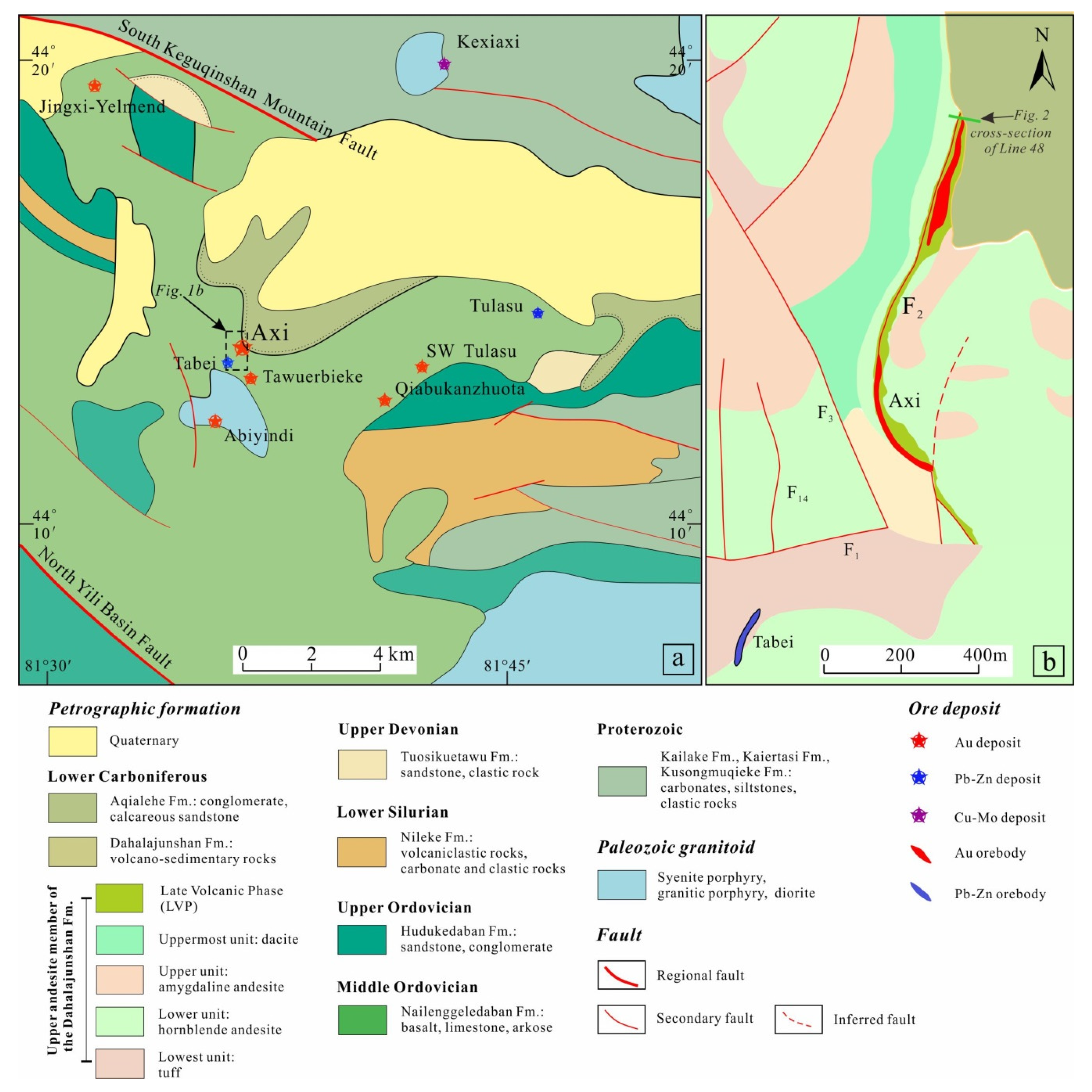
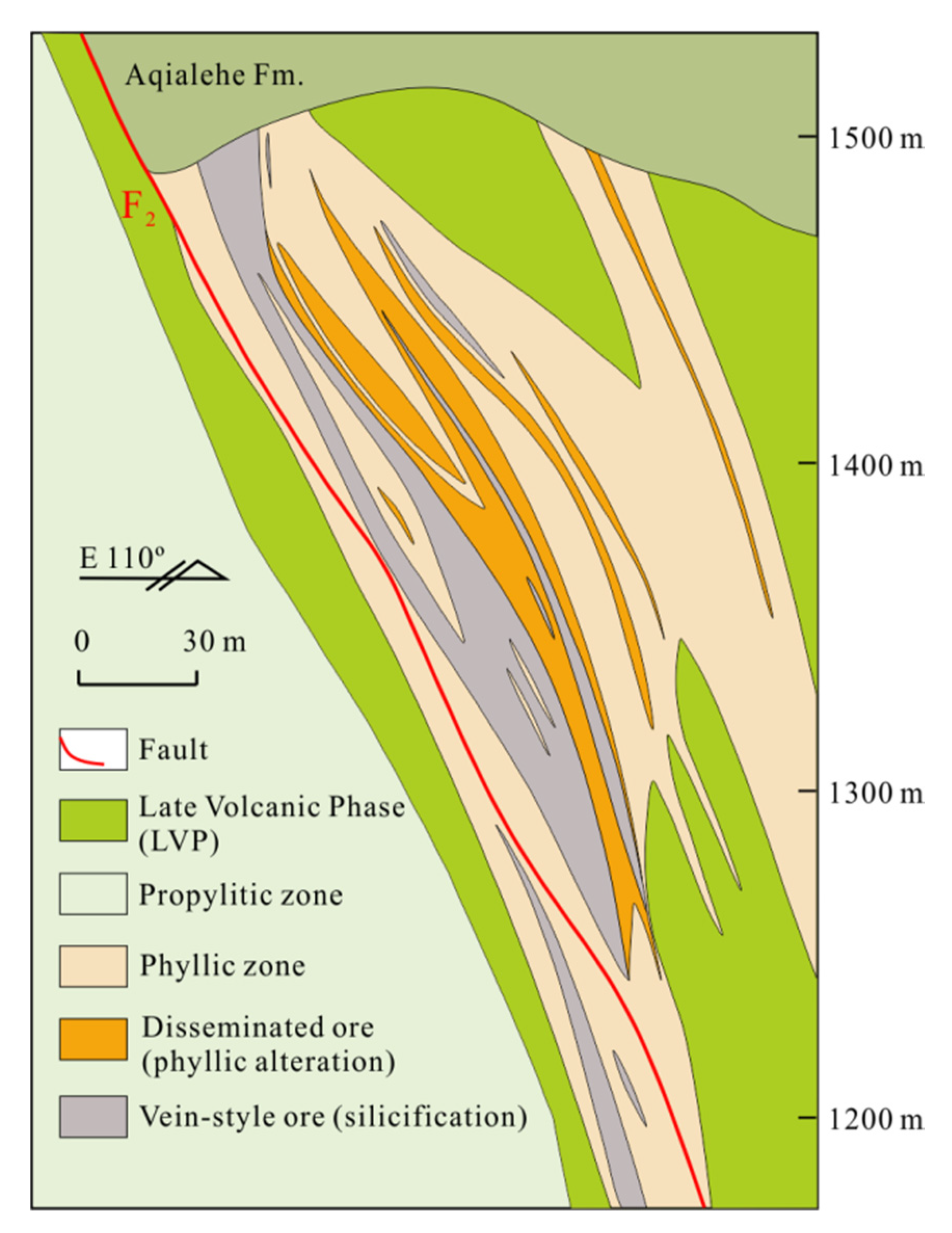
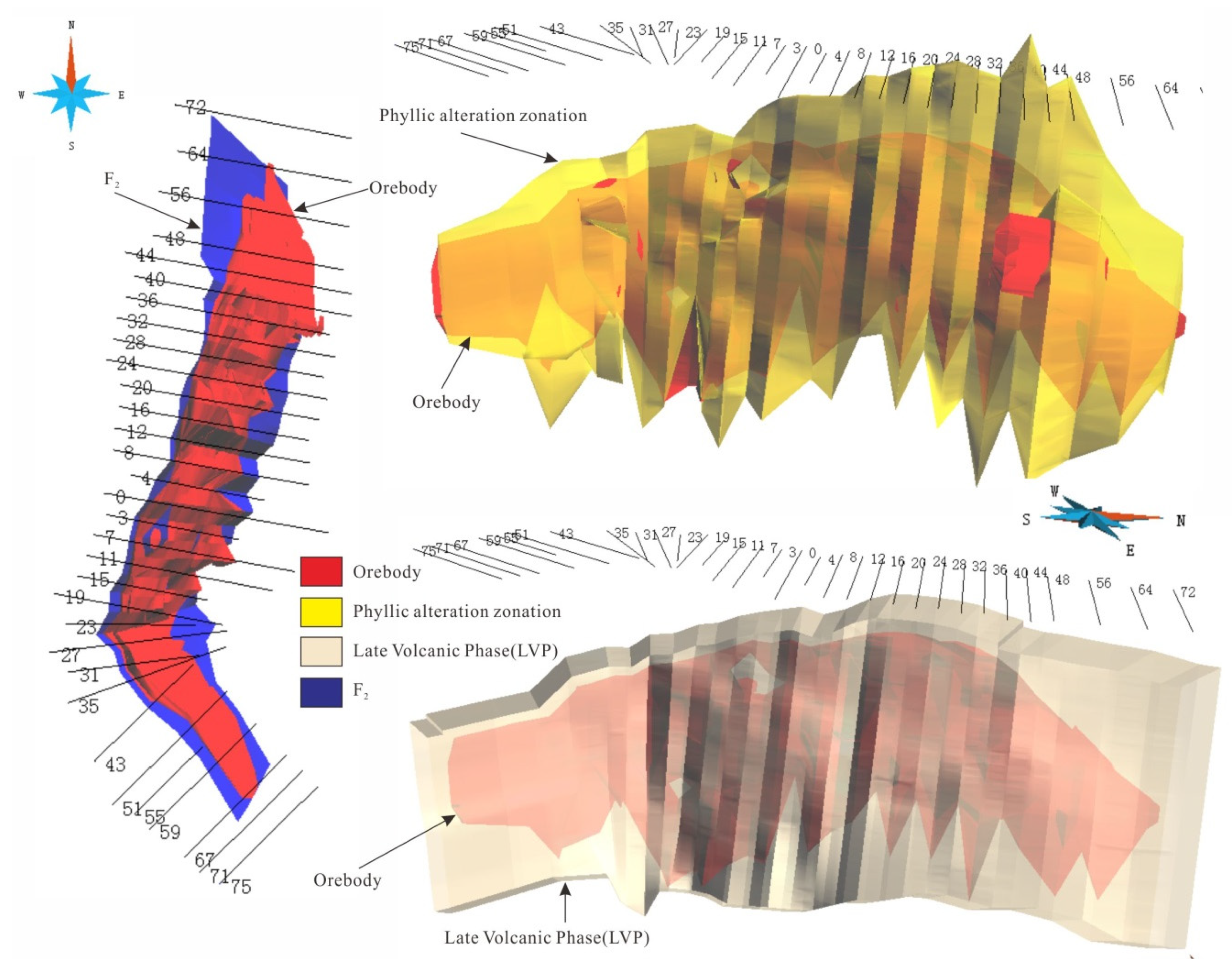
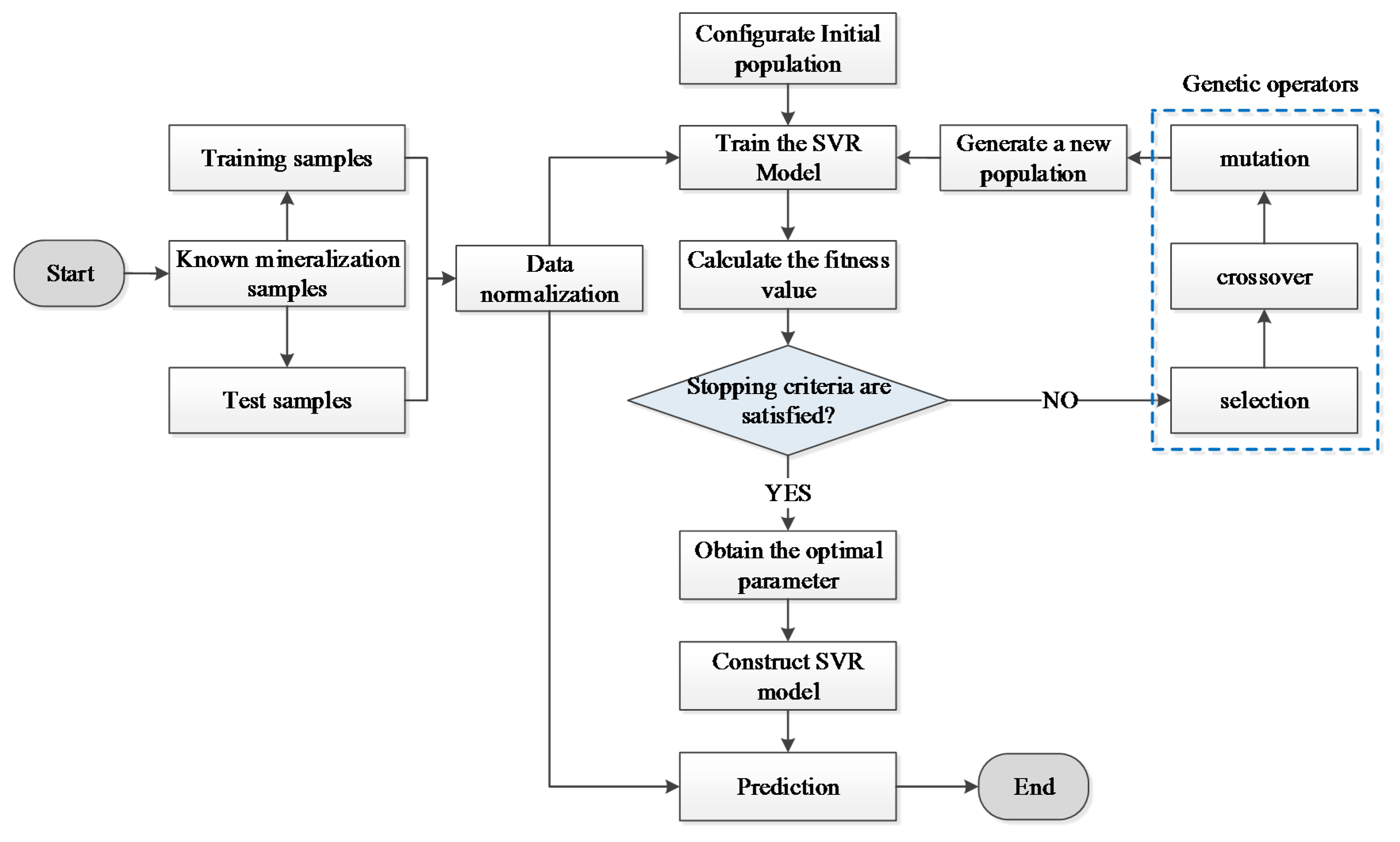
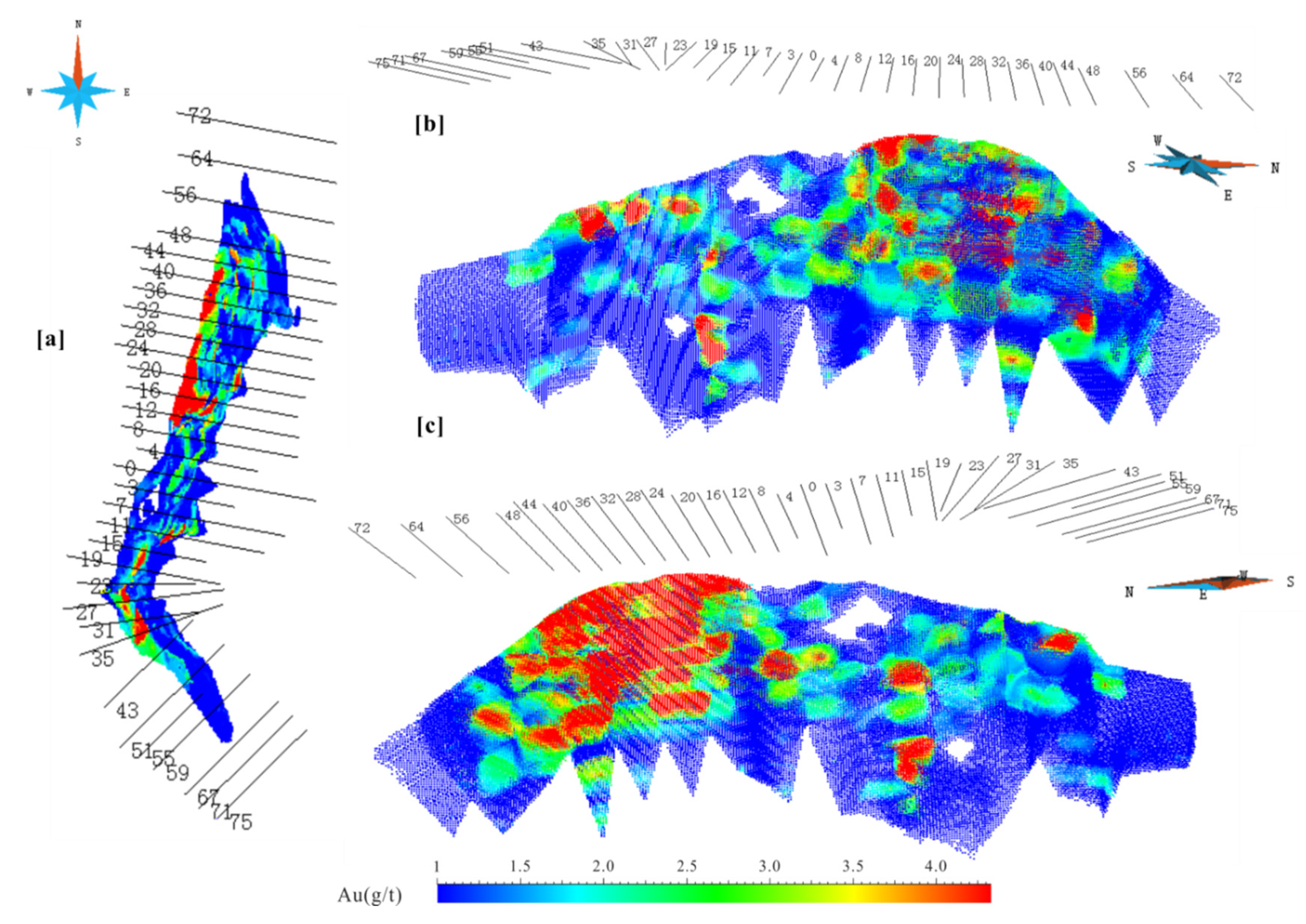
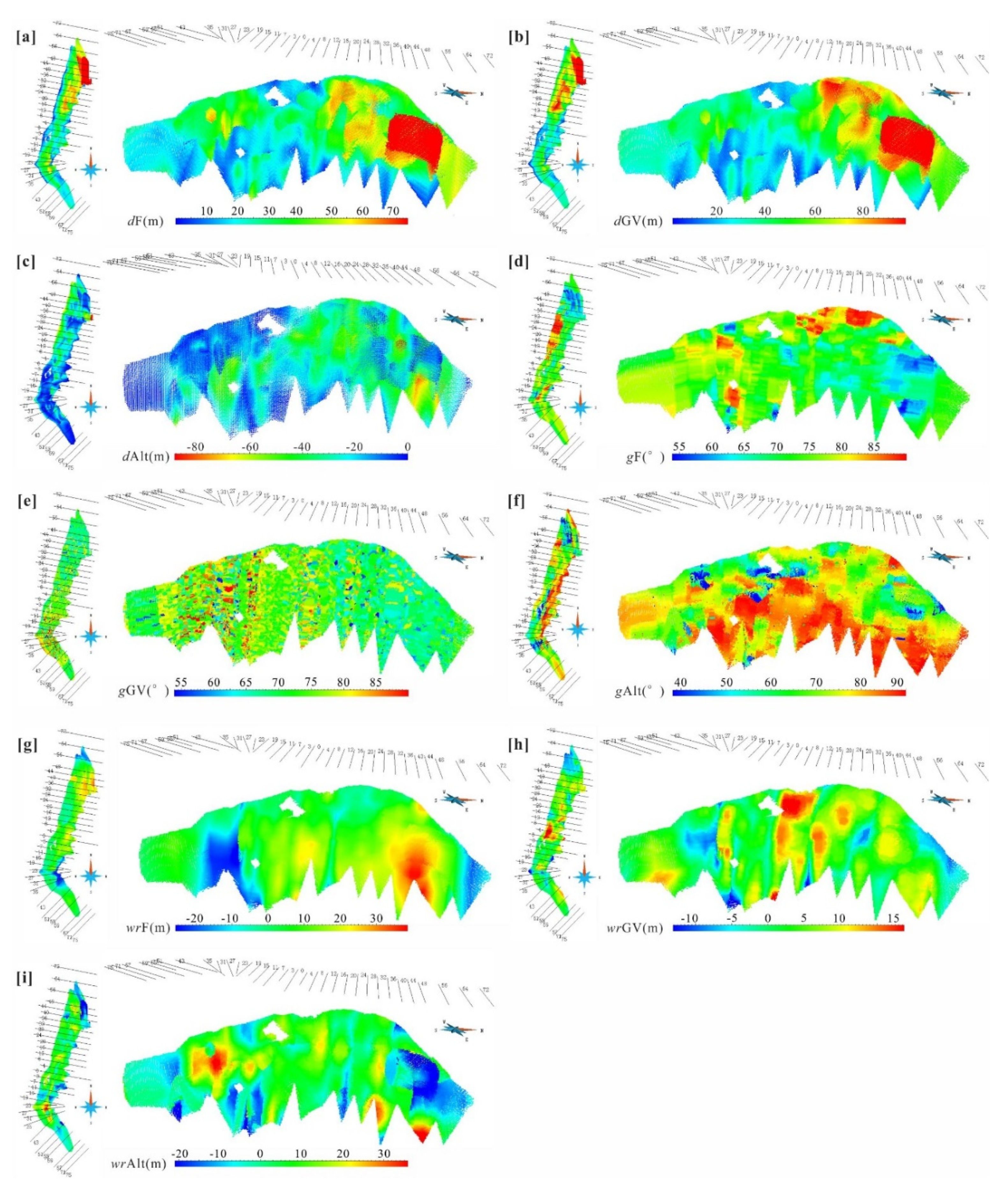
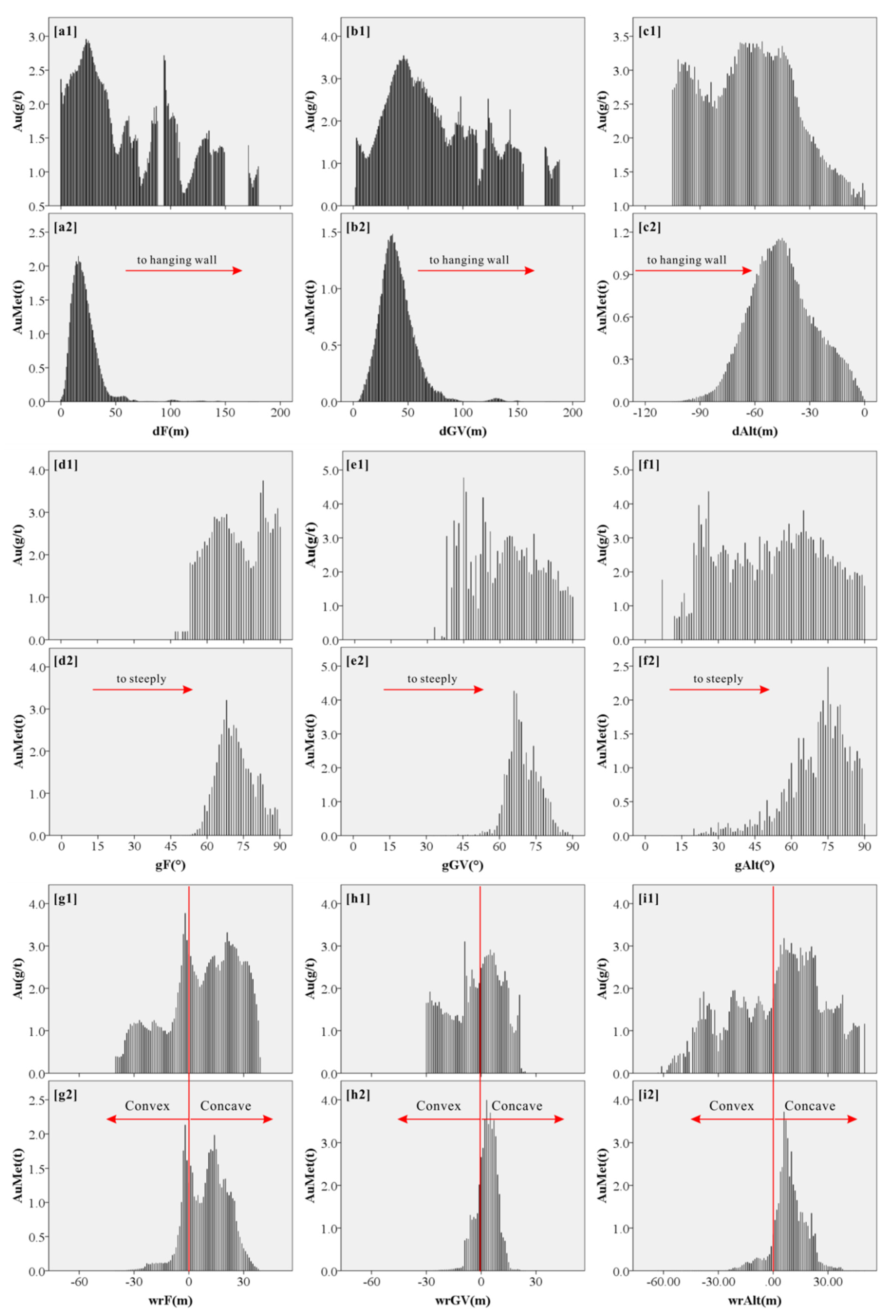
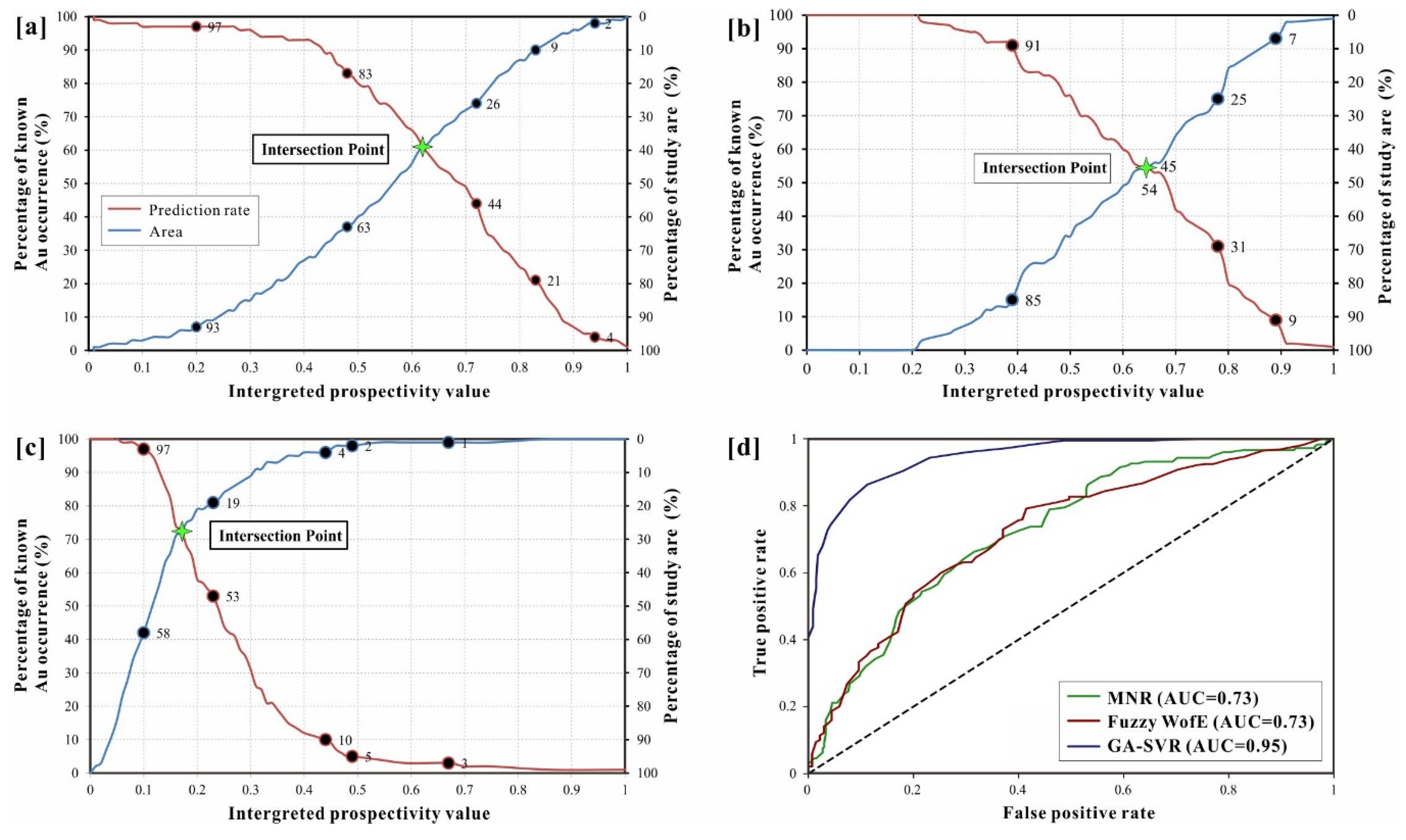
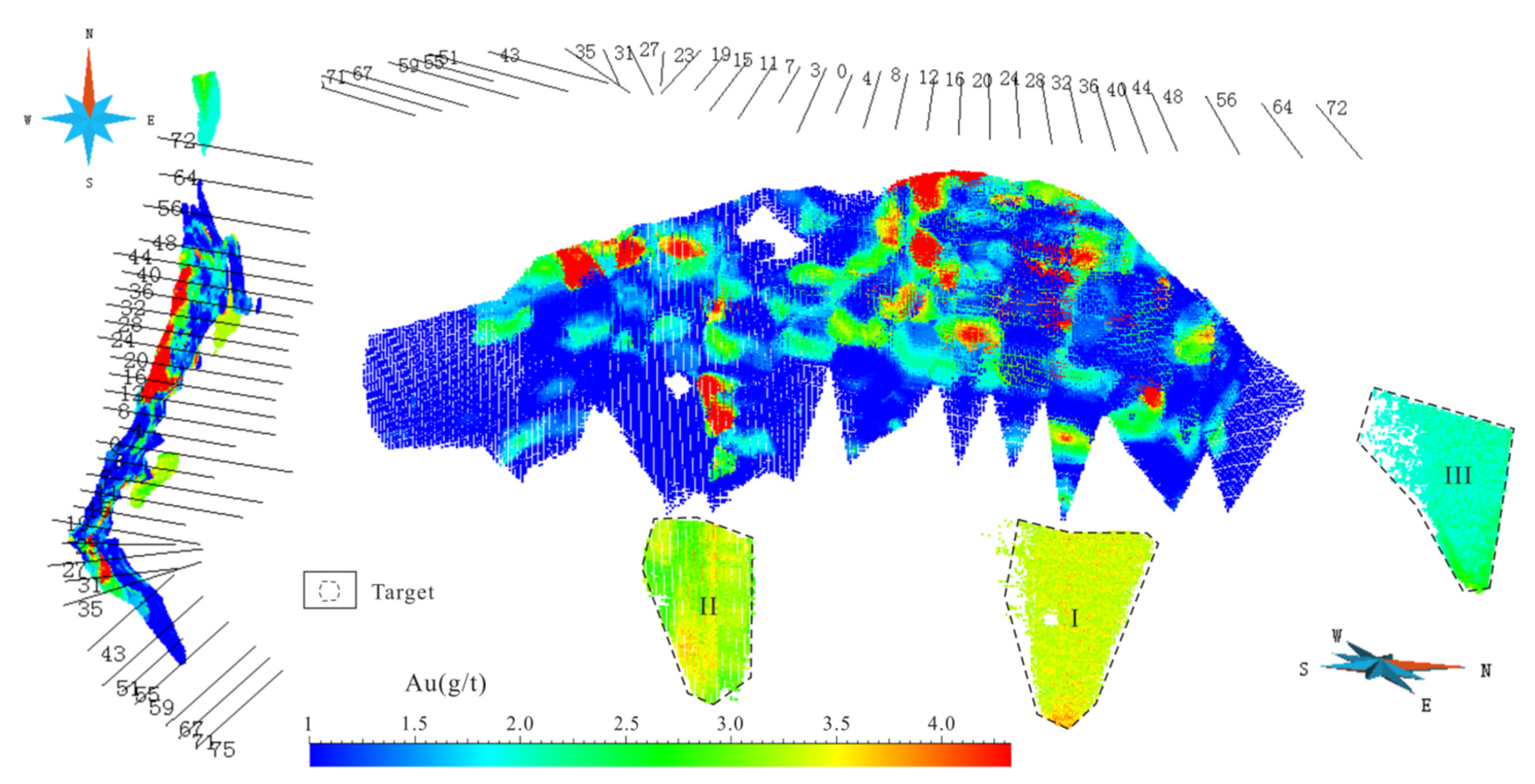
| Training Set | RMSE | MAE | R2 |
|---|---|---|---|
| GA-SVR | 0.49 | 0.41 | 0.89 |
| GS-SVR | 1.12 | 0.58 | 0.71 |
© 2020 by the authors. Licensee MDPI, Basel, Switzerland. This article is an open access article distributed under the terms and conditions of the Creative Commons Attribution (CC BY) license (http://creativecommons.org/licenses/by/4.0/).
Share and Cite
Mao, X.; Zhang, W.; Liu, Z.; Ren, J.; Bayless, R.C.; Deng, H. 3D Mineral Prospectivity Modeling for the Low-Sulfidation Epithermal Gold Deposit: A Case Study of the Axi Gold Deposit, Western Tianshan, NW China. Minerals 2020, 10, 233. https://doi.org/10.3390/min10030233
Mao X, Zhang W, Liu Z, Ren J, Bayless RC, Deng H. 3D Mineral Prospectivity Modeling for the Low-Sulfidation Epithermal Gold Deposit: A Case Study of the Axi Gold Deposit, Western Tianshan, NW China. Minerals. 2020; 10(3):233. https://doi.org/10.3390/min10030233
Chicago/Turabian StyleMao, Xiancheng, Wei Zhang, Zhankun Liu, Jia Ren, Richard C. Bayless, and Hao Deng. 2020. "3D Mineral Prospectivity Modeling for the Low-Sulfidation Epithermal Gold Deposit: A Case Study of the Axi Gold Deposit, Western Tianshan, NW China" Minerals 10, no. 3: 233. https://doi.org/10.3390/min10030233
APA StyleMao, X., Zhang, W., Liu, Z., Ren, J., Bayless, R. C., & Deng, H. (2020). 3D Mineral Prospectivity Modeling for the Low-Sulfidation Epithermal Gold Deposit: A Case Study of the Axi Gold Deposit, Western Tianshan, NW China. Minerals, 10(3), 233. https://doi.org/10.3390/min10030233








